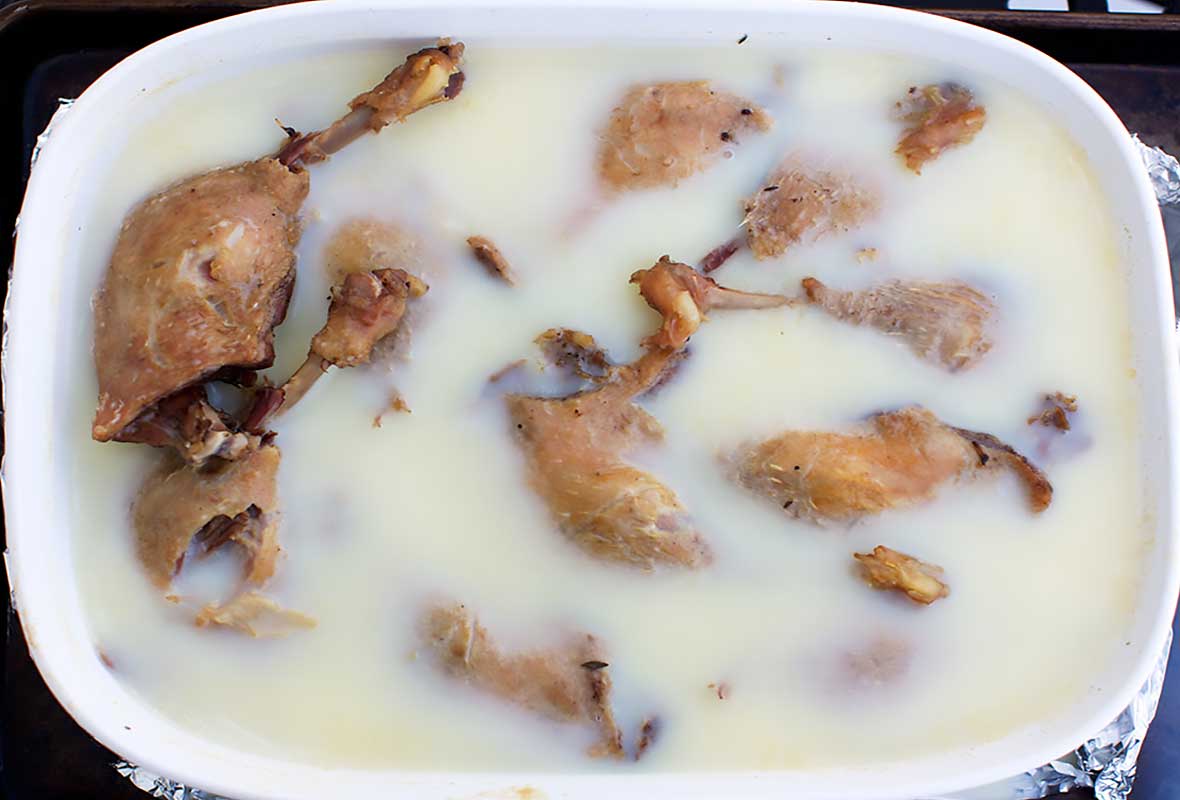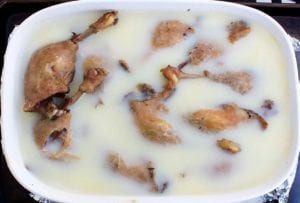
Duck confit is a traditional way to yield the most magnificently rich and tender duck imaginable. Although historically, that wasn’t even the objective. This classic French method of salt curing duck legs and then braising them in duck fat was relied on to preserve meat without refrigeration for long periods of time. But we keep this technique in our arsenal for the astoundingly tender results it never fails to incur. The process itself takes a couple days but the actual work from you is minimal. Although it’s so fantastically delicious you’ll want to devour the entire batch in a single sitting, resist. The duck confit lasts a long time when stored in rendered duck fat, in keeping with its heritage, and can be used in an endless number of soul-satisfying ways. [Editor’s Note: We’ve listed a few uses for duck confit below, but it’s just the beginning. Use your imagination. And then let us know in a comment below.]–Angie Zoobkoff
What To Serve With Duck Confit
- Added to cassoulet
- Seared and plated alongside potatoes that you’ve chopped and tossed with rendered duck fat and roasted until golden brown and crisp or atop a mound of mashed potatoes
- Seared and served alongside a simple salad of frisee or other bitter greens with a light sherry vinaigrette to cut the richness of the duck
- Shredded and stirred into wild mushroom risotto
- Shredded and tossed with your favorite pasta or gnocchi
- Turned into duck rillettes
- Nibbled alongside pickled grapes
- Sliced thinly and tucked into quesadillas or paninis with caramelized onions
- Shredded and used in place of pork or shrimp in Vietnamese summer rolls
- Warmed and served with almost any mushroom dish, perhaps something along the lines of this cool weather mushroom side dish
- Warmed and savored straight up with nothing but a glass of Bordeaux or Côtes du Rhône
Want to save this?

Duck Confit
Ingredients
- 1 cup kosher salt
- 1 tablespoon fresh ground black pepper
- Leaves from 4 fresh thyme sprigs
- 2 bay leaves, crumbled
- 1 teaspoon ground allspice
- 10 duck legs
- 2 to 3 quarts rendered duck fat*
Instructions
- Combine the salt, pepper, thyme leaves, bay leaves, and allspice in a bowl. Rub the seasoning mixture all over the duck legs. Place the seasoned duck legs in a large container, cover, and refrigerate for 24 hours. [Editor’s Note: Because of the salt brine, duck confit can tend to be a touch salty. If you prefer, you can decrease the time the duck is brined to 12 to 18 hours to lessen the saltiness in the finished duck confit.]
- Preheat the oven to 250°F (120°C).
- Remove the legs from the salt mixture, rinse well under cold water, and pat completely dry with paper towels.
- Heat the duck fat in a large pot over low heat until it melts, about 5 minutes.
- Arrange the duck legs in 2 snug layers in a large ovenproof casserole dish or Dutch oven. Pour enough of the melted fat over the legs to completely cover them by 1 inch. Heat the casserole over moderately low heat until the fat comes to a very gentle simmer.
- Turn off the heat beneath the casserole and cover it. Place a rimmed baking sheet lined with foil on the oven rack and place the casserole on the baking sheet. Bake the duck until it’s very tender and almost falling off the bone, 2 1/2 to 3 hours.
- Using tongs, gently remove the legs from the fat, being mindful that the meat is literally almost tender enough to fall off the bone. To devour the duck confit immediately, serve the confit as-is or, if you prefer the contrast of shatteringly crisp duck skin against knee-wobblingly tender duck meat, warm a skillet over medium heat and sear the duck confit, skin side down, until the skin is golden brown and crisp. To save the duck confit for later, place the entire duck legs in a resealable container and carefully pour the rendered duck fat through a fine-mesh sieve set over the duck. You want the duck confit to be completely covered. It’s imperative that the fat completely covers the meat. Let cool completely and then cover tightly and store in the refrigerator for up to 2 weeks. (Alternately, you can pull the skin off the confit, gently tug the meat from the bones in large chunks, place the duck confit meat in a resealable container, and then cover the meat with the rendered duck fat and refrigerate until your craving strikes. Ready to use at an instant’s notice.)
Notes
*Where To Buy Rendered Duck Fat
Buying a large quantity of rendered duck fat can become pricey pretty quickly if you rely on those wee glass jars found at specialty markets. We’re talking half a paycheck! Instead, consider asking your butcher if it’s possible to special order a couple quarts rendered duck fat for you. Or if you happen to have a local duck farm, ask if they’d be willing to sell you some rendered duck fat (aka liquid gold) along with some duck legs. You can also buy tubs of rendered duck fat online from numerous purveyors, including Farm Fresh Duck, Hudson Valley Foie Gras, and D’Artagnan.
Explore More with AI
Nutrition
Nutrition information is automatically calculated, so should only be used as an approximation.
Recipe Testers’ Reviews
Well. Now I know what all the fuss is about when it comes to duck confit. The flavor of the duck meat is mind-blowing. It’s meltingly tender and rich and I really had to stop myself from “sampling” so there would be enough left for the cassoulet! This recipe is very simple to make with outstanding results. The duck did come out a little salty, which would be easy enough to balance out in a stew, cassoulet or other dish, but if you were going to serve the legs grilled on top of a salad or something, you’d want to be very careful in adding any salt to the remainder of the dish. I halved the recipe so it made 5 legs. (One to sample and the rest for the cassoulet.) The type of duck wasn’t labeled on the package but the total weight was 2.5 pounds and I needed 1.5 quarts of rendered duck fat to cover those 5 legs. The cook time was accurate at 2 1/2 hours as the meat was falling off the bone at that point.
I have always wanted to make duck confit. The seasoning for the duck took mere minutes to prepare and season the legs. Melting the duck fat the next day after washing the legs took about 5 minutes over a very low heat. The legs fit in a single layer in a rectangular ceramic baker so I was assured that the legs would be completely covered by the melted fat. The result after 3 hours in the low oven was tender fall off the bone duck meat. I put half the legs into a tightly sealed container and covered them with stained duck fat for storage in the fridge. Two of the legs I put into a small container with some of the fat for a friend. I’m not sure what she used it for but she was thrilled to receive it. For the last 2 legs, I pulled the meat off, heated it in a pan to crisp it, and served it on a bed of greens with sliced potatoes cooked in some of the duck fat. This is not a dish for everyday but certainly worthy of special occasions and weekends. I contacted a local duck farm and they were willing to sell me a 2-kg pail of duck fat for less than $20.00 when I bought the legs from them, too. I got a 2-kg package of 8 duck legs and used 3/4 of the pail of duck fat when making the confit.











